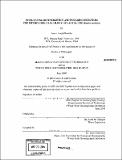Integrating bioenergetics and foraging behavior : the physiological ecology of larval cod (Gadus morhua)
Author(s)
Ruzicka, James Joseph, 1966-
DownloadFull printable version (6.860Mb)
Other Contributors
Woods Hole Oceanographic Institution.
Advisor
Scott M. Gallager.
Terms of use
Metadata
Show full item recordAbstract
How do larval cod, Gadus morhua, balance foraging effort against the high cost of swimming in a viscous hydrodynamic regime? A respirometry system was developed to measure the activity metabolism of individual larvae. The cost of swimming was modeled as a power-performance relationship (energy expenditure as a function of swimming speed) and as the cost of transport (the cost to travel a given distance). The cost of transport was high relative to juvenile and adult fish, but larvae swam more efficiently as they grew and became better able to overcome viscous drag. A large-volume observation system was developed to record foraging behavior in three dimensions. There are two phases of the saltatory search cycle used by larval cod: the burst which serves to position larvae within a new search volume and the pause when larvae search for prey. Burst characteristics did not change under different prey treatments, but pause duration increased while foraging capacity and swimming activity decreased when prey were absent. Longer pause durations could reflect greater effort to visually process each search volume when prey were difficult to find. Reduced swimming activity could also be an energy conservation strategy under unfavorable foraging conditions. By applying the cost of swimming model to the observed swimming intensity of freely foraging larvae, foraging activity was estimated to account for up to 80% of routine metabolism. A trophodynamic model was developed incorporating observed foraging behavior and swimming costs to estimate the prey density required to cover all metabolic demands. (cont.) Small larvae (5mm) can survive on typical mean Georges Bank prey densities in mildly turbulent conditions. Larger larvae (>6mm) can survive even at high turbulence levels. Simulated alternative foraging strategies predict that when predator-prey contact rates are high, the greatest net energy gain is realized with short pause durations. When predator-prey contact rates are low, larvae should achieve greater net energy gains by remaining at rest for extended periods. Larvae observed foraging in the absence of prey do not change behavior as much as the simulation model predicts, suggesting that they use a prey encounter maximization strategy rather than an energy conservation strategy.
Description
Thesis (Ph. D.)--Joint Program in Oceanography/Biology (Massachusetts Institute of Technology, Dept. of Biology; and the Woods Hole Oceanographic Institution), 2004. Includes bibliographical references.
Date issued
2004Department
Joint Program in Biological Oceanography.; Woods Hole Oceanographic Institution; Massachusetts Institute of Technology. Department of BiologyPublisher
Massachusetts Institute of Technology
Keywords
Joint Program in Biological Oceanography., Biology., Woods Hole Oceanographic Institution.